#The Birka Ring
Explore tagged Tumblr posts
Text
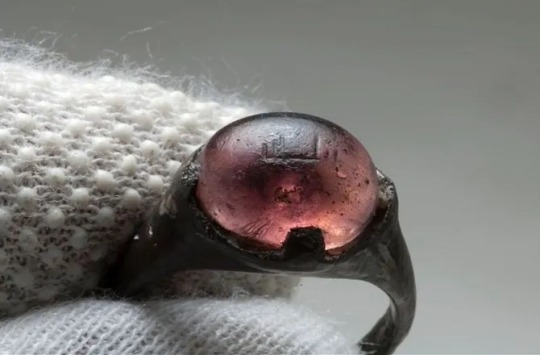

The Viking Age ring with the Arabic inscription
“for Allah” The Birka Ring
Featuring a pink-violet colored stone with an inscription that reads “for Allah” or “to Allah,” the silver ring was found during the 1872-1895 excavations of grave fields at the Viking age trading center of Birka, some 15.5 miles west of Stockholm.
4K notes
·
View notes
Text

Hands Up
#palestine#stamps#postal stamps#pink#arabic#free palestine#فلسطين 🇵🇸#free palestine 🇵🇸#Ring#Islam#For Allah#viking#jewee#jewelry#artifact#The Birka Ring#Shirin Neshat#Offered Eyes#text#eye#black and white#photography#art#iranian#2015
25 notes
·
View notes
Text

In a fascinating archaeological find, a 9th-century Viking woman's burial revealed a ring inscribed with the Arabic phrase "for Allah," highlighting intriguing cultural connections between Norse and Islamic worlds.
Discovered in Birka, Sweden, a prominent Viking trading hub, the ring's inscription points to the extensive trade routes and interactions of the Viking Age. This discovery suggests that the Viking woman, possibly of high status, had significant contact with the Islamic world or was part of a broader exchange network.
3K notes
·
View notes
Text
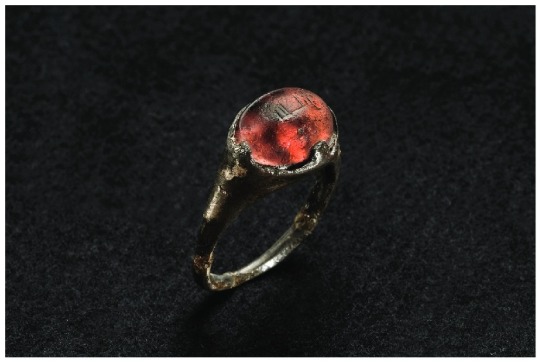
A ring found in Birka, Sweden, made in the 9th century. Made from silver and set with a coloured glass stone, it is inscribed with Arabic Kufic writing reading "for/to Allah". It is the only ring found at a Scandinavian archaeological site with Arabic writing
Blog: https://artifactsmuseumhistory.blogspot.com
448 notes
·
View notes
Text
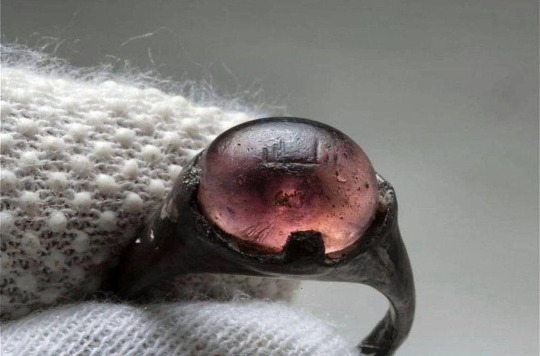
This ring was discovered on a woman buried around 1,200 years ago in Birka, an ancient Viking city located 30 km (19 miles) west of contemporary Stockholm, Sweden. What sets this ring apart is the inscription "for Allah" in Kufic Arabic, commonly used between the 8th and 10th centuries. It provides evidence of direct contact between Vikings and the Abbasid Caliphate, the third caliphate succeeding the Islamic prophet Muhammad.
155 notes
·
View notes
Text
Istanbuli kajakalauz
Főbb török kaják Istanbulban (de egész Törökországra érvényes)
Döner, ezt mindenki ismeri. Alapvetően kétféle van, a dürüm, amit pitába tekernek, és a yarım ekmek, amit fél cipóba tesznek. Et: borjú (Üsküdartól keletre egyre inkább birka), vagy tavuk: csirke. Rendkívül változatos, jobb helyen ezerféle dolgot lehet kérni bele. Nem szükséges összehasonlítani a körúton, vagy körtéren vagy bárhol Kapikulétól nyugatra kapható speciessel. Ha azt mondod: hepszi, akkor mindenből lesz benne. Kötelező hozzá a hideg ayran! Van persze tányéros verzió is, döner kasesi…, többnyire a turisták eszik ott. Szinte mindenhol, ahol leülni lehet, vannak edényekben ingyenesen különféle csípős cuccok, pici paprikák, uborkák, savanyított dolgok, nem árt vigyázni, mert legtöbbje életveszélyesen rúg.
Kebapok – nyárson sült, többnyire borjú darálthús, -Adana kebap (húsok(eredetileg bárány), sült paradicsom, különféle sült és nyers zöldségek+lepénykenyér, alias pide, mint a naan -Urfa kebap, kevesebb csípős fűszer, mint Adanában -Iskender kebap (kb ugyanaz, csak meleg lepénykenyérrel, forró paradicsomszószszal, olvasztott vajas joghurttal leöntve), ez a kebapok királya, nem a legolcsóbb, de nem kihagyható! Egy rendes adag két személyre bőven elég. -sis-kebap, apró nyesedék húsdarabkák nyárson, hasonló megy Anatóliában čöp-kebap (szó szerint „szemét”-kebap néven Ciğer vagy karaciğer – máj, lehet kebap is, de dönerbe is rakják Patlican (patlidzsan). ez az, aminek hangzik. Vega.
Sarma, szőlőlevélbe tekert rizs-darált hús
Köfte – kicsi darált húsgolyók, minifasírt borjúból (et, dana), csirkéből (tavuk). Híres a Tekirdağ Köftesi (ez Rodostó török neve), nyilván maga a fejedelem is evett ilyet, meg a Mikes Kelemen is.
Dolmates – ez is szőlőleválbe töltött cucc, bármi lehet benne, zöldség de akár tengeri izé is
Izgara, mangal, ezek faszénen sült bármik lehetnek, húsok, padlizsán, máj, bármi
Cacik (dzsadzsik)– ez a görög tzatziki, apróra vágott uborka, fokhagyma, joghurt
Piláfok (pilav), rizs, legtöbbször van benne törökmogyoró vagy pisztácia, esetleg sáfrány, egész étkezésnek is eszik, elég, ha meglocsolják egy kis csirkepörkölt szaftjával, szegények kajája, imádom.
levesek – olcsók. Pl: Iskembe çorbasi – pacalleves (FÚJJJJ) Mercimek çorba– vöröslencse-leves (NYAMM), fél ekmek+negyed citrom+ayran: fullos kaja. Fasulye-nyilván, hogy bableves
Pide, börek – kb rétes, peynirli=sajtos, patatesli=krumplis, káposztás, húsos, spenótos,stb, és ezek mindenféle keveréke, bármelyik kicsi pékségnek kinéző boltban van, csak a kemencét kell figyelni hátul, az legyen! Olcsó, laktató.
Pogácsa, kerek perec – (poğaça, simit: poacsa, szimit), ezek is bárhol, utcán is, kerekes üveges kocsikról, legtöbbször frissen, melegen, 10-30Tl.
Halak – (balik) sok helyen, főleg tengerparton érdemes enni, ahol még ott ring a halászcsónak, nagyon finom faszénen sült halak, nem olcsó, remélhetően nem a szarrá szennyezett Boszporuszból, hanem a Márvány- vagy Égei-tengerről (Marmara- Ege-denizli).
Kagyló – az utcán sokfelé kínálgatják a feketekagylót (siyah midye, midye), 3-4 db ott helyben állva elég, a főtt vagy sült kagylóhúst jó fűszeres rizzsel keverik és visszatöltik a héjba, le kell törni a felső héjat, és azzal betolni szájba, nem drága, fincsi.
Édességek – dondurma, baklava, helva, lokum, pismaniye, tavuk göğsü, tulumba, ezekről nem sokat tudok, mivel kívül esnek érdeklődési körömön, túlontúl tömények nekem. Az biztos, hogy gyermekeim, midőn bakfiskorba léptek, irtózatos, ipari mennyiséget zabáltak fel mindezekből, amiért aztán akkora pattanásos seggük nőtt, mint egy nílusi vízilónak. De már elmúlt.
Klasszikus török reggeli – (kahvalti) friss fehér cipó (ekmek), főtt tojás (yumurta), lágy fehér sajtok (peynir), legalább kétféle olajbogyó (zeytin), fekete magos és zöld magozott, ott nem baszakodnak a megtöltésével, vaj (tereyağı), szeletelt friss uborka, paradicsom, paprika, 4-5-féle gyümölcslekvár és dzsem, némi marhafelvágott, a végére sütik, főként egy hókiflire hasonlító és egy brownie-hoz hasonlatos. És persze tea (çay), kávé (kahve), tej (süt), és gyümölcslevek.
128 notes
·
View notes
Text

Viking Love Pairs: New Insights into Sexual Diversity in the Viking Age
In recent years, several Viking graves have been discovered throughout Europe where two men are found hand in hand. These findings have sparked a new debate about the sexual orientation of the Vikings.
The initial discoveries of this nature were made in the 1990s. In a grave near the Swedish town of Birka, skeletons of two men were found touching shoulders. These men, aged between 25 and 30, were equipped with weapons and jewelry indicating their high social status.
Subsequent years revealed additional discoveries, including:
2001: A grave in Norway where two men were found hand in hand. These men, aged between 20 and 30, were dressed similarly. 2002: A grave in Sweden where two men were found hand in hand. These men, aged between 30 and 40, held a sword hilt in hand. 2014: A grave in Denmark where two men were found hand in hand. These men, aged between 25 and 30, had a gold neck ring. The interpretation of these findings is not conclusive. Some scholars believe they constitute evidence of Viking homosexuality, while others argue that the men were simply friends or relatives showing unity in their final resting place.
It is crucial to note that there was no clear definition of homosexuality in the Viking Age. Viking society was complex, with a variety of sexual norms. The relationship between the men in these graves might have been perceived as platonic or romantic. Regardless of interpretation, the discoveries of Viking graves with two men holding hands are significant. They demonstrate that homosexuality was not unknown during the Viking Age, contributing to a broader understanding of historical sexual diversity.
Viking sexual norms were intricate and diverse, lacking uniform rules or regulations and varying based on region and social class.
Homosexuality was not prohibited or condemned in the Viking Age. There are indications that, in some cases, it was accepted and even celebrated. The aforementioned discoveries of Viking graves with two men hand in hand serve as examples, suggesting that homosexual relationships were acceptable for at least some Viking men. Literary references also point to homosexual relationships, such as the Icelandic Saga of Egil Skallagrimsson, which narrates that Egil, the saga's hero, had a homosexual relationship with another man.
The discoveries and literary references indicate that homosexuality was at least acceptable for some Viking men. However, it is essential to recognize the absence of a uniform definition of homosexuality in the Viking Age, with sexual norms varying based on region and social class.
#VikingLove#SexualDiversity#VikingHistory#Archaeology#LGBTQHistory#HistoricalDiscoveries#VikingCulture#HomosexualityInHistory#GenderNorms#AncientLGBTQ#VikingSociety#ArchaeologicalFindings#EgilSkallagrimsson#VikingAge#gayart#queer#LGBT#muscle#manlovesman#gaylove
78 notes
·
View notes
Text

Masterlist ~ << Previous Chapter ~ Next Chapter >>
Astarion x Dark Urge Chapter 23 -- Step Seven Rating: E Tags: Angst, Fluff, hurt/comfort, slow burn
Chapter Summary:
Rose & co flawlessly execute a seven step plan to explain the disappearance of the druid without letting anyone cast suspicion onto them.

"Goblin Trash!"
"Who the hells you callin' trash, ya ugly bitch!"
The sanctum, once filled with cheers of praise, now rumbled with cacophonous shouts as two True Souls snarled in each other's faces. Flail in Minthara's hand, and a hot poker in Gut's.
Ah, what a wonderful way for a plan to come together.
Step One: Cover Their Tracks
The pits were cleared, as far as Rose was concerned. Loose arrows, daggers, and other signs of their interference had been erased. Not even the bits of broken potion bottles were left behind, thanks to the sharp eyes of Shadowheart and Lae'zel.
The last part to this was a form of insurance.
Step Two: Manipulate the Evidence
Halsin's rampage left little to be used to their advantage. The only corpse left intact was Birka's-- it would have to do. Lae'zel hoisted the body over her shoulder, holding it secure by the legs. It was Wyll's idea to cover it with a cloth to minimize prying eyes from asking questions.
The party slipped out from the pits, taking careful steps along the rickety wooden bridge. Goblin voices from the atrium began to reach their ears as they filed one-by-one to the other side.
"Alfira, are you ready?" Rose whispered to the bard.
The tiefling nodded, taking a moment to breathe and get into character. "I won't let you down," she promised with a smile, then strode towards the crowded room.
Step Three: Create a Distraction
"An ode to The Absolute!" Alfira cheered, positioning herself front and center before Priestess Gut's platform. She strummed a chord, letting the sound ring.
"Hear hear!" a goblin cheered. Then another. And another!
Goblins cheered as they gathered around the brightly colored tiefling, singing a song of praise to their Goddess. The tune was as common as a tavern's ditty, with clever wordplay to change the main character from a nameless hero to The Absolute.
"Praise the Absolute!" Priestess Gut threw her hands in the air, shouting on cue when the tiefling's tail pointed towards her.
"Praise the Absolute!" Alfira responded, encouraging the crowd to cheer with her.
One by one, goblin patrols detoured from their path in the hall towards the impromptu celebration. No one noticed the cleric hiding in the shadows.
"Clear," the Shadowheart whispered to the group behind her.
In quick succession, Lae'zel, Rose, and Wyll shuffled past the crowd. A rowdy cheer covered their quickened steps towards Minthara's doorway. Shadowheart was close behind, ensuring they hadn't been made.
Wyll connected his tadpole to Shadowheart's, allowing her to see and hear through his senses as the rest of the group entered the office.
"When the time is right, give Alfira the signal," Rose instructed through their mutual connection, "I trust your instincts."
The cleric nodded.
Step Four: Cause a Scene
The crystalline eye was the first to spot them, abruptly pausing its movements as they entered the room. What few goblins remained loyal to their posts leered at them as they crossed the chasm.
Lae'zel unceremoniously dropped the bundle to Minthara's feet, ripping the cloth off to reveal Birka's mauled corpse.
"What is the meaning of this?!" Minthara shouted. Goblins from around the room wielded their weapons.
"Bear's gone," Rose stated, calmly walking to the front of her group, "prison's empty."
Minthara eyed the assassin skeptically. Rose's tadpole wriggled, being invited-- no, ordered, to show the drow what she saw. Rose obliged.
The memory opened up to her-- well, a memory. One which she created herself. A performance of her own, if one should call it that.
"It's quieter than I expected..." Rose's voice spoke out, as her vision neared the steps. The smell of blood lingered in the air.
She hurried down the steps, coming to a bloody mess of corpses strewn about.
Minthara tried to dig deeper, to see more. Rose allowed it.
The scene plays on, with the memory making a show of looking throughout the pits. It starts with investigating the crater, examining the piles of gore, and then closing in on Birka's corpse, with bear slashes clear as day across her body.
The Drow had seen enough. Her eyes cast downward to the corpse at her feet, giving it a light nudge with her boot.
"The wounds are fresh," Minthara observed.
"Exactly. I sent one of mine on the hunt, already, he couldn't have gotten far."
Step Five: Control the Narrative
The orb floated to the women as they conversed, slowly orbiting the goblin corpse on the ground before rotating slowly to look at Rose.
Listening.
"The pits are empty, except for the corpses left behind,-- if you consider piles of guts and gore as a corpse," Rose explained to the orb. "There's a giant crater in the ground indicating the guards didn't let him go without a fight. Based on the freshness of blood, this happened within the last hour."
Row by row, Rose's tapestry of lies was revealed. The patterns hidden by her tone made for a complete design. Minthara glanced over to the goblins who listened in. Her fists clenched.
Step Six: Divert the Blame
"Did you speak with Spike? He was supposed to be getting information from the sniveling human boy."
"No one was there, Commander," Rose lied, "nor did I hear any sounds of an ongoing interrogation."
"And the Priestess? Has she been made aware?"
"She seems to be focused on other events, at the moment."
Right on time, the raucous cheers of the goblins carried into the room. The singing had reached its peak, bringing with it the percussion of drums, claps, and metal clanging.
"ARRRGH!" Minthara kicked the corpse into the chasm. Fury burned within her striking red eyes, threatening to engulf the room with her wrath. Without another word, she stormed from the room, flying down the steps towards the sanctum.
Cheers and claps came to an abrupt stop with the crashing of a brazier to the ground.
"Well look who came to join us!" Priestess Gut's voice traveled, "bit of a pissy entrance, wouldn't ya say?"
"Goblin Trash!"
"Who the hells you callin' trash, ya ugly bitch!"
What once had been filled with cheers of praise, now rumbled with cacophonous shouts as both women brandished their weapons. Flail in Minthara's hand, and a hot poker in Gut's.
Step Seven: Watch
Rose took her time strolling from Minthara's office to the scene of the commotion. By the time she got there, the two were swinging at each other. Minthara blocked a thrust from the hot iron, then swung back with her flail.
The crowd was divided between cheering for the Priestess, and supporting the Drow.
"Yous think it's our fault for losing the druid?!" the priestess snarled, "who's idea was it to keep the damn beast alive?!"
Minthara dodged another strike as the searing metal slashed towards her, "if we sent him to Moonrise, we'd know where the weapon is, you short-sighted idiot!"
Priestess Gut stumbled back after a blow to the face, wiping the blood from her lip.
"You always acted like you was better than us-- all that talk about us being equal under The Absolute, but you don't believe it one bit do ya? But she chose me too, ya know."
The drow charged forth, swinging relentlessly and overwhelming the priestess. Several goblins jumped in to defend Gut, while others joined to fight alongside Minthara. It was not long before chaos broke out in the temple.
And Rose's crew slipped out, unnoticed.

Next Chapter >> (to be posted)
#bg3#baldur's gate 3#astarion#dark urge#astarion x dark urge#baldurs gate 3#durge#bg3 fic#fanfic#angst#slowburn#astarion romance#longfic#Rosestarion#Fic: I've Got You#Jellymelly writes#durgestarion#bg3 fanfiction#bg3 fanfic
9 notes
·
View notes
Text

A ring found in Birka, Sweden, made in the 9th century. Made from silver and set with a coloured glass stone, it is inscribed with Arabic Kufic writing reading “for/to Allah”. It is the only ring found at a Scandinavian archaeological site with Arabic writing
2 notes
·
View notes
Text
More nonsensical One Piece ramblings branching off my last post...
What if the people of the sky are actual angels... like actual disciples of the Gods.
The more I think about Eneru possibly having another God Zoan devil fruit like Luffy, the more I hope it’s true. It would just make so much sense! What if he came from a line of rulers from Birka that inherited this Godly devil fruit through the generations somehow? It would explain his insistence on being a God, and possibly why the so-called priests chose to follow him... maybe that’s why they’re called priests to begin with now that I think of it because maybe in Birka they were literal priests to a person with literal god powers.
And each sub-culture of Sky People could be disciples of a different God, as theorized in my last OP-related post.
This is all purely speculation, but...
Lunarians worshiped Nika, God of the Sun (which could also explain why King was so adamant about seeing him again)
Shandorans worshiped the Earth God, but lost the devil fruit (possibly to Imu, who is very much still alive; could also be the big battle Calgara talks about that started the void century and almost wiped out all the Shandorans. Here’s a random screenshot that gave me chills just now.) EDIT: The name of the god is probably literally Vearth how did I not think of this sooner.
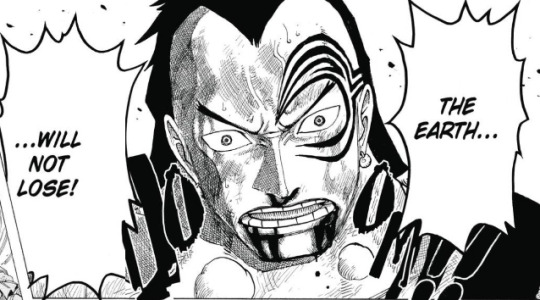
Skypieans maybe worshipped the forest god, which is why they might consider Upper Yard “Holy Land” This one is really a stretch but either way, if true, they seem to have also lost the devil fruit of their god.
And Birkans worship the God of Rain/Storms, which is now in possession of Eneru, a deranged, disillusioned individual who only seeks power.
Like... yea the people of the sky started out representing angels because oohh people living in the sky must be from heaven!! But like... what if it’s so much deeper than just that? What if all of them are so much more important than we initially thought?
I’ll leave off on the quote from the ponegliff “Hold the truth in your heart, keep your mouth silent. We are the ones who weave history with the ringing of the golden bell.”
4 notes
·
View notes
Text

A Viking era ring inscribed with the words 'for Allah', found in the grave of a woman who was buried 1200 years ago in Birka, 25 km west of modern-day Stockholm. The ring constitutes a unique material evidence of direct contact between the Vikings and the Abbasid Caliphate.
Source: Facebook
Archeology and History
0 notes
Text

49 notes
·
View notes
Text

Peace
#palestine#stamps#postal stamps#pink#arabic#free palestine#فلسطين 🇵🇸#free palestine 🇵🇸#Ring#Islam#For Allah#viking#jewee#jewelry#artifact#The Birka Ring#Shirin Neshat#Offered Eyes#text#eye#black and white#photography#art#iranian#2015#aesthetic#photos
11 notes
·
View notes
Photo
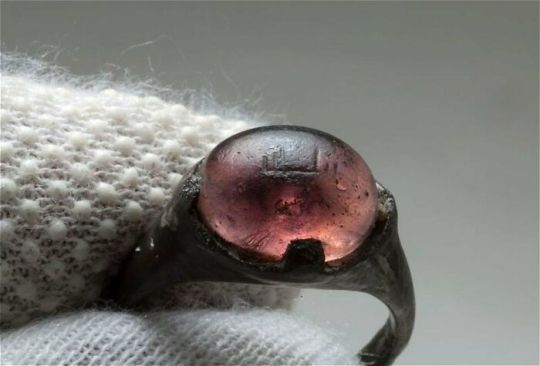
A Viking era ring inscribed with the words 'for Allah', found in the grave of a woman who was buried 1200 years ago in Birka, 25 km west of modern-day Stockholm. The ring constitutes a unique material evidence of direct contact between the Vikings and the Abbasid Caliphate. (one of many sources!)
#jewelry#medieval#medieval fashion#fashion#sweden#swedish fashion#middle east#middle eastern fashion
11K notes
·
View notes
Text
(En)Elbaf Part 2
So a few things about 1066 (Spoilers! Obviously):
Saul is most likely the burn-scarred man
Kid is most likely on Elbaf
It looks like Hajrudin and his crew were there on Ohara.
SO WHAT DOES THIS MEAN FOR THE FUTURE?
Elbaf, Ohara and Vegapunk are now inextricably linked. Vegapunk and his satellites are are also heavily linked to the moon. Each of his satellites are named after craters or something else related to the moon.
In Enel's cover story we see Vegapunk's homeland of Karakuri Island and the scientist Doctor Tsukimi who fixes up automata that were seemingly created by the sky people in the past.
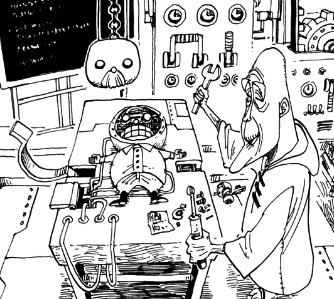
We see very similar automata working on Egghead island in the background. We now know that Vegapunk has learned things about the ancient kingdom and the void century via the books from Ohara and that it appears that he even has some technology from that time.

The large robot indeed has a very Viking-esque appearance to it which must be noted, invoking both Elbaf and the Ancient Giants (who may well be from Elbaf themselves).
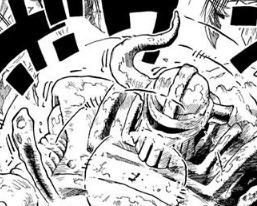
People online have been pointing out that the Space Pirates jolly roger looks exceptionally similar to Doctor Vegapunk himself (with a very looooong head! Hey, who knows maybe this can link to Long Ring Long Land somehow).

It seems like Elbaf will be an arc of reunions, Dorry, Brogy, Oimo, Kashi, Saul, maybe Hajrudin and his crew and perhaps the Kid Pirates too. A lot of allies gained by Usopp and heavy ties to Usopp and Robin’s developments in Enies Lobby.
Speaking of Hajrudin, we can see what appears to be him, Gerd and Goldberg being captained by Saul in Chapter 1066! How odd, seeing as Saul was not from Elbaf and didn’t seem to have a very high opinion of him when he spoke to Robin. I wonder what changed in the month between the Buster Call and his return to Ohara with his new crew.
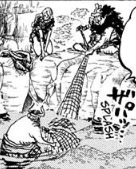
Now as to why I believe he is the burn-scarred man? He’s really the only person who could be, he has the most info about the void century thanks to his retrieval of the books and he was most likely burned by the fires of Ohara during the Buster Call or by Kuzan’s ice (which was most likely the thing that saved him! Cheeky “Ice Time Capsule” we really should have realised he was alive from that).
This only compounds the link between a few key things to me, ancient technology, Elbaf, and the sky people. Sky People -> Ancient Tech -> Vegapunk and Saul -> Elbaf. Its a trail of connections and I still need something a little more concrete, but this could very well be paving the way for info about Birka, which I believe establishes a key connection between the Giants and the sky people. I think Birka is the key and that is what would bring us to the return of Enel. I should make some kind of web to show how everything connects but I’d look like a conspiracy theorist...
if Elbaf is an arc of reunions, both friends, for Usopp and Robin, and enemies/rivals if Kid appears, (Which I believe he will!). A lot of people are hoping for Vivi’s return here and if the theme of reunions really does ring true, I think we can expect this! Kid and Enel could cause some real havoc together, electromagnets anyone?
I unfortunately can’t really find a way to tie Urouge into this any more than I already have, other than the fact he’s now the only Supernova not to be a major arc character yet. His time will come soon.
Sorry if this was kind of light compared to the previous part, I just wanted to make sure I had my thoughts out there about this. Information is coming at such a fast pace now, if I’m right about this we’ll know before long. A strange tidbit- an early concept for Film Red was in fact the return of Enel, but it was shot down. I can’t work out if that’s good or bad for the theory, I’ll leave that with you.
All the best everyone and I hope to have more to share soon.
8 notes
·
View notes
Text
My last message was a long time ago and I apologize for the lack of updates in between the go fund me and now.

Unfortunately we faced issue after issue, one of them being the post office giving our wedding rings to someone else. This wedding preparation was a nightmare as we kept running into that sort of issues. Of course we haven't been reimbursed by the post office or for all the other issues we faced but we're now officially married.


Writing on Tumblr has been difficult those past years and so is opening FFXIV and play. It's been a while I'm struggling between wanting to share why and being scared to open up too much. I have made mistakes, did my best to apologize when I could but a lot of events also drained the pleasure I had to play.
I'm not ready to explain everything, but know it has to do with being used, taking responsibilities for others and thus suffering the consequences to protect friendships, hospitals, bullying, betrayal and some more trigger warning issues. I'm trying to slowly write to explain but I'm unsure if I will ever post it.
I can't promise I'll return to Tumblr and if I'll continue my art journey, but I'll be back on Balmung under the name "En'to Tecil". If I was in your friendlist as Ilwe'ran, I'll still be there. Ilwe'ran and Carina finished their RP journey for now while En'to and Birka have a lot to do.. rather Birka had to stop En'to and his stupid ideas, that's a bit more realistic.
See you soon in FFXIV. I love you dearly my friends.
30 notes
·
View notes